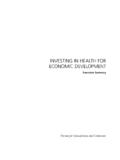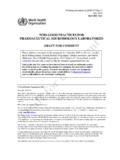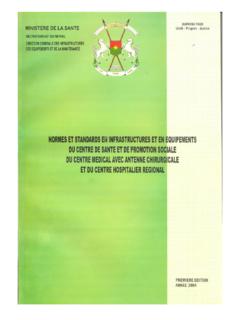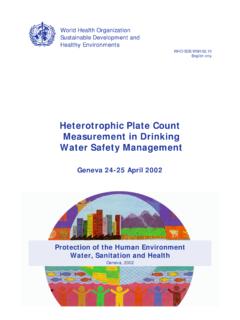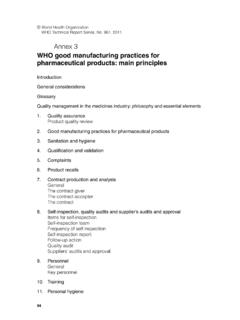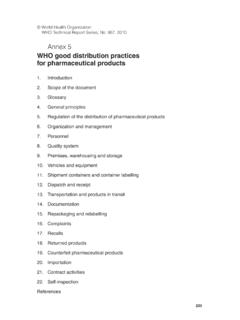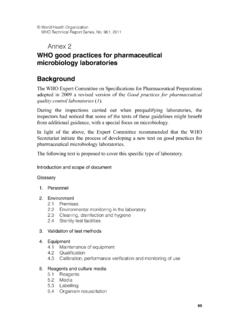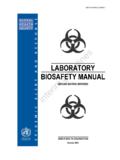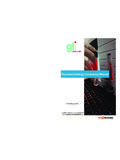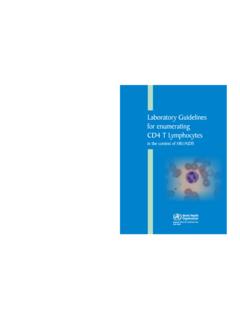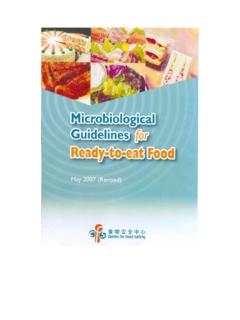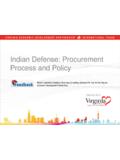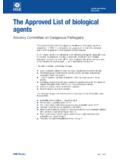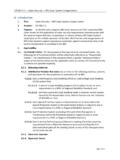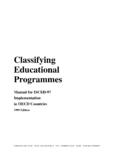Transcription of CHAPTER 4 Faecal pollution and water quality
1 51 CHAPTER 4 Faecal pollution and water qualityFaecal pollution of recreational water can lead to health problems because of thepresence of infectious microorganisms. These may be derived from human sewageor animal CHAPTER relates to recreational water activities where whole-body contact takesplace ( , those in which there is a meaningful risk of swallowing water ). ApproachWater safety or quality is best described by a combination of sanitary inspection andmicrobial water quality assessment. This approach provides data on possible sourcesof pollution in a recreational water catchment, as well as numerical information onthe actual level of Faecal pollution . Combining these elements provides a basis for arobust, graded, classification as shown in Figure SIMPLIFIED CLASSIFICATION MATRIXS anitary inspectionMicrobial water quality assessmentDecreasing qualityDecreasing qualityVERY GOODGOODFAIRVERY POORPOOR52 GUIDELINES FOR SAFE RECREATIONAL water ENVIRONMENTSIs the water body used for contact recreation?
2 Unclassified (reassess if usage changes)NOSanitary inspection categoryMicrobial water quality assessmentYESVery goodGoodFairPoorVery poorGood (but unsuitable forseveral days after rain)Very good (but unsuitablefor several days after rain)Fair (but unsuitable forseveral days after rain) water subject to occasional andpredictable deterioration**where users can be shown to be effectively discouraged from entering the water following occasional and predictable waterquality deteriorations (linked to, for example, rainfall), the area may be upgraded to reflect the water quality that users areexposed to, but only with the accompanying explanatory SIMPLIFIED FRAMEWORK FOR ASSESSING RECREATIONAL water ENVIRONMENTSThe results of the classification can be used to: grade beaches in order to support informed personal choice; provide on-site guidance to users on relative safety; assist in the identification and promotion of effective management interventions; and provide an assessment of regulatory some instances, microbial water quality may be strongly influenced by factorssuch as rainfall leading to relatively short periods of elevated Faecal pollution .
3 Expe-rience in some areas has shown the possibility of advising against use at such timesof increased risk and, furthermore, in some circumstances that individuals respondto such messages. Where it is possible to prevent human exposure to pollution hazardsin this way this can be taken into account in both grading and advice. Combiningclassification (based on sanitary inspection and microbial quality assessment) withprevention of exposure at times of increased risk leads to a framework for assessingrecreational water quality as outlined in Figure resulting classification both supports activities in pollution prevention ( ,reducing stormwater overflows) and provides a means to recognise and account forlocal cost-effective actions to protect public health ( , advisory signage about rainimpacts). Health effects associated with Faecal pollutionRecreational waters generally contain a mixture of pathogenic and non-pathogenicmicroorganisms.
4 These microorganisms may be derived from sewage effluents, therecreational population using the water (from defecation and/or shedding), livestock(cattle, sheep, etc.), industrial processes, farming activities, domestic animals (suchas dogs) and wildlife. In addition, recreational waters may also contain free-livingpathogenic microorganisms ( CHAPTER 5). These sources can include pathogenic organ-isms that cause gastrointestinal infections following ingestion or infections of theupper respiratory tract, ears, eyes, nasal cavity and and illness due to recreational water contact are generally mild and sodifficult to detect through routine surveillance systems. Even where illness is moresevere, it may still be difficult to attribute to water exposure. Targeted epidemiolog-ical studies, however, have shown a number of adverse health outcomes (includinggastrointestinal and respiratory infections) to be associated with faecally pollutedrecreational water .
5 This can result in a significant burden of disease and number of microorganisms (dose) that may cause infection or disease dependsupon the specific pathogen, the form in which it is encountered, the conditions ofexposure and the host s susceptibility and immune status. For viral and parasitic pro-tozoan illness, this dose might be very few viable infectious units (Fewtrell et al.,1994; Teunis, 1996; Haas et al., 1999; Okhuysen et al., 1999; Teunis et al., 1999).In reality, the body rarely experiences a single isolated encounter with a pathogen,and the effects of multiple and simultaneous pathogenic exposures are poorly under-stood (Esrey et al., 1985).The types and numbers of pathogens in sewage will differ depending on the inci-dence of disease and carrier states in the contributing human and animal populationsand the seasonality of infections.
6 Hence, numbers will vary greatly across differentparts of the world and times of year. A general indication of pathogen numbers inraw sewage is given in Table both marine and freshwater studies of the impact of Faecal pollution on thehealth of recreational water users, several Faecal index bacteria, including Faecal strep-tococci/intestinal enterococci (see Box ), have been used for describing waterquality. These bacteria are not postulated as the causative agents of illnesses in swim-mers, but appear to behave similarly to the actual faecally derived pathogens (Pr ss,1998).Available evidence suggests that the most frequent adverse health outcome asso-ciated with exposure to faecally contaminated recreational water is enteric illness,such as self-limiting gastroenteritis, which may often be of short duration and maynot be formally recorded in disease surveillance systems.
7 Transmission of pathogensthat can cause gastroenteritis is biologically plausible and is analogous to waterbornedisease transmission in drinking- water , which is well documented. The associationhas been repeatedly reported in epidemiological studies, including studies demon-strating a dose response relationship (Pr ss, 1998). CHAPTER 4. Faecal pollution AND water QUALITY5354 GUIDELINES FOR SAFE RECREATIONAL water ENVIRONMENTSTABLE EXAMPLES OF PATHOGENS AND INDEX ORGANISM CONCENTRATIONS IN RAW SEWAGEaPathogen/index organism Disease/roleNumbers per 100 105 Clostridium perfringens sporesIndex organism6 104-8 104 Escherichia coliIndex organism (except specific strains)106 107 Faecal streptococci/intestinal enterococciIndex 103-4 8000 Shigella 1000 VirusesPoliovirusesIndex organism (vaccine strains),180-500 000poliomyelitisRotavirusesDiarrhoea, vomiting400 85 000 AdenovirusesRespiratory disease, gastroenteritisnot enumeratedbNorwalk virusesDiarrhoea, vomitingnot enumeratedbHepatitis AHepatitisnot enumeratedbParasitic protozoacCryptosporidium parvum 39 Entamoeba histolyticaAmoebic lamblia 20 000 Helminthsc(ova) 11 Ancylostomaspp.
8 And Necator 4aH ller (1988); Long & Ashbolt (1994); Yates & Gerba (1998); Bonadonna et al. important pathogens in sewage have yet to be adequately enumerated, such as adenoviruses, Norwalk-like viruses,hepatitis A numbers vary greatly due to differing levels of endemic disease in different cause effect relationship between Faecal or bather-derived pollution and acutefebrile respiratory illness (AFRI) and general respiratory illness is also biologicallyplausible. A significant dose response relationship (between AFRI and Faecal strep-tococci) has been reported in Fleisher et al. (1996a). AFRI is a more severe healthoutcome than the more frequently assessed self-limiting gastrointestinal symptoms(Fleisher et al., 1998). When compared with gastroenteritis, probabilities of con-tacting AFRI are generally lower and the threshold at which illness is observed cause effect relationship between Faecal or bather-derived pollution and earinfection has biological plausibility.
9 However, ear problems are greatly elevated inbathers over non-bathers even after exposure to water with few Faecal index organ-isms (van Asperen et al., 1995). Associations between ear infections and microbio-logical indices of Faecal pollution and bather load have been reported (Fleisher et al.,1996a). When compared with gastroenteritis, the statistical probabilities are gener-ally lower and are associated with higher Faecal index concentrations than those forgastrointestinal symptoms and for Faecal STREPTOCOCCI/INTESTINAL ENTEROCOCCIF aecal streptococci is a bacterial group that has been used as an index of Faecal pollution in recre-ational water ; however, the group includes species of different sanitary significance and survival char-acteristics (Gauci, 1991; Sinton & Donnison, 1994). In addition, streptococci species prevalence differsbetween animal and human faeces (Rutkowski & Sjogren, 1987; Poucher et al.)
10 , 1991). Furthermore, the tax-onomy of this group has been subject to extensive revision (Ruoff, 1990; Devriese et al., 1993; Janda, 1994;Leclerc et al., 1996). The group contains species of two genera Enterococcusand Streptococcus(Holt etal., 1993). Although several species of both genera are included under the term enterococci (Leclerc et al.,1996), the species most predominant in the polluted aquatic environments are Enterococcus faecalis, and E. durans(Volterra et al., 1986; Sinton & Donnison, 1994; Audicana et al., 1995; Borrego et al.,2002).Enterococci, a term commonly used in the USA, includes all the species described as members of the genusEnterococcusthat fulfil the following criteria: growth at 10 C and 45 C, resistance to 60 C for 30 min,growth at pH and at NaCl, and the ability to reduce methylene blue. Since the most commonenvironmental species fulfil these criteria, in practice the terms Faecal streptococci, enterococci, intestinalenterococci and Enterococcusgroup may refer to the same order to allow standardization, the International Organization for Standardization (ISO, 1998a) hasdefined the intestinal enterococci as the appropriate subgroup of the Faecal streptococci to monitor ( ,bacteria capable of aerobic growth at 44 C and of hydrolysing 4-methylumbelliferyl-b-D-glucoside in thepresence of thallium acetate, nalidixic acid and 2,3,5-triphenyltetrazolium chloride, in specified liquidmedium).
